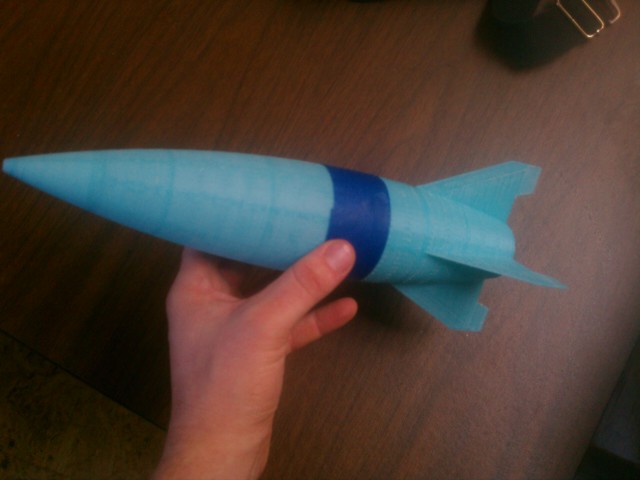Difference between revisions of "3D Printed Aerodynamic Parts"
m (fix image) |
|||
| (8 intermediate revisions by 3 users not shown) | |||
| Line 1: | Line 1: | ||
[[File:3D_Printed_Cigar_Rocket.jpg|thumb]] | |||
For | For [[User:holmaschine|holmaschine]], the advantage of 3-D printed model rocket parts is the ability to create a very thin and structurally efficient shape without concern over fabrication and the relative alignments of subparts. Components can be printed true to final form (+/-) with only light treatment required to smooth outer surfaces so long as the basic restrictions of the manufacturing method are understood. | ||
| Line 7: | Line 7: | ||
Several prototypes have been created in both 29mm and 65mm diameter, using a tangent-ogive profile. | Several prototypes have been created in both 29mm and 65mm diameter, using a tangent-ogive profile. | ||
TO DO: write code to generate g-code directly instead of using SolidWorks and Slic3r. | TO DO: write code to generate g-code directly instead of using SolidWorks and Slic3r. | ||
WHY: avoid 15 min + delay time using slicer, better match to theoretical shape without. | WHY: avoid 15 min + delay time using slicer, better match to theoretical shape without. | ||
TO DO: Model payload supports integral with structural elements. | TO DO: Model payload supports integral with structural elements. | ||
WHY: Reduce number of fasteners and/or adhesive required. | WHY: Reduce number of fasteners and/or adhesive required. | ||
| Line 17: | Line 22: | ||
One prototype printed, downrated to smaller engine size until proven. Will mount adapter to aft bulkhead using (4) #4-40 screws. | One prototype printed, downrated to smaller engine size until proven. Will mount adapter to aft bulkhead using (4) #4-40 screws. | ||
= Actual Rocket = | |||
The picture above shows a 3D printed 2-part rocket. 65mm max diameter, 29mm motor bay, tangent ogive curve with internal 2-way structural ribs and support for airspeed sensor pitot tube at nose. Made on [[Type_A_Machine|our Type-A Machine]]. | |||
[[Category:3DPrinting]] | |||
Latest revision as of 19:08, 23 December 2013
For holmaschine, the advantage of 3-D printed model rocket parts is the ability to create a very thin and structurally efficient shape without concern over fabrication and the relative alignments of subparts. Components can be printed true to final form (+/-) with only light treatment required to smooth outer surfaces so long as the basic restrictions of the manufacturing method are understood.
Nose Cones
Several prototypes have been created in both 29mm and 65mm diameter, using a tangent-ogive profile.
TO DO: write code to generate g-code directly instead of using SolidWorks and Slic3r.
WHY: avoid 15 min + delay time using slicer, better match to theoretical shape without.
TO DO: Model payload supports integral with structural elements.
WHY: Reduce number of fasteners and/or adhesive required.
Fin Cans
One prototype printed, downrated to smaller engine size until proven. Will mount adapter to aft bulkhead using (4) #4-40 screws.
Actual Rocket
The picture above shows a 3D printed 2-part rocket. 65mm max diameter, 29mm motor bay, tangent ogive curve with internal 2-way structural ribs and support for airspeed sensor pitot tube at nose. Made on our Type-A Machine.
